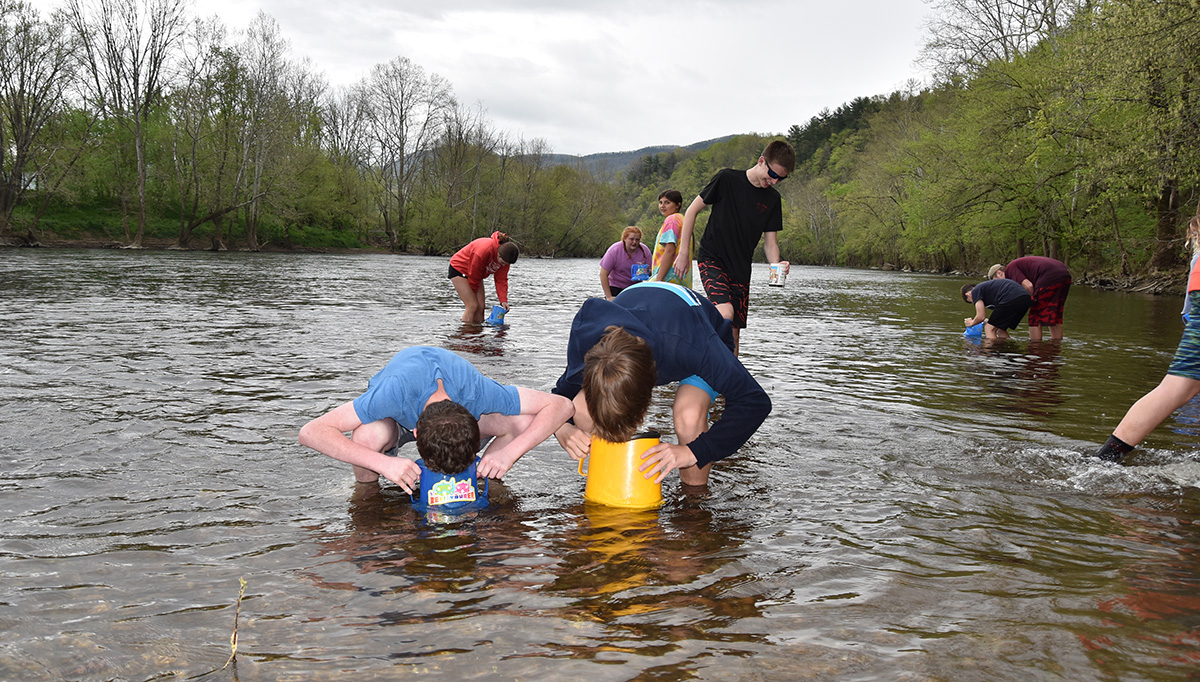By Bruce Ingram
Photos by Bruce Ingram
“You only take care of the things you love, and you only love the things you know,” said Beth Wiegandt when asked why she enjoys shepherding seventh graders down the James River every spring. But Wiegandt, who operates Your Outdoor Classroom, is not just showing a few middle schoolers the glories of the James. Indeed, this activity is part of a Project Wild outreach program that has grown to such a degree that annually every single seventh grader enrolled in Botetourt County Public Schools has the opportunity to take a short trip down the upper James at no cost to them.
The Project WILD program is an interdisciplinary conservation and environmental education curriculum and materials that focus on wildlife and conservation for all educators—formal and non-formal, pre-K through high school. The Virginia Department of Wildlife Resources (DWR) provides in-service training for educators in support of the wildlife related Science Standards of Learning as well as essential skills in math, language arts, and civics. Project WILD provides educators with the tools, training and resources needed to engage students in active, hands-on learning about wildlife. The activities in the guides aid in developing students’ critical thinking, problem solving and decision-making skills through the use of cross curricular lessons.
Tim Miller, a Project Wild volunteer and Education and Outreach Coordinator for the Mountain Castles Soil & Water Conservation District, explains the Botetourt James River program’s origins and goals.
“We piloted this canoe program with Ronda Malcolm’s eighth grade STEM class three years ago,” he said. “Ronda was the driving force to get it approved by the school administration. We always had hoped to expand it so that every Botetourt County student could participate, and thanks to an annual grant from the Chesapeake Bay Restoration Fund, we’ve been able to do that.

Students receiving tips on how to run a Class I rapid, which begins their journey down the James.
“We split each middle school into two semesters based on when students have science,” Miller continued. “Additionally, each school is split over two days, with two different paddling groups each day. So normally there are 15 or fewer canoes on the river at a time. The group that is not canoeing has some land-based activities. This can vary from year to year, based on teacher requests, but in the past we have conducted water quality testing, done a web of life activity, and had a brief tour of some conservation practices used on the Botetourt farm that hosts us. Our goal is to show how human activities can impact the James and to make sure every student has a personal encounter with the river.”
Miller added that Wiegandt does a great job in chauffeuring students down the river safely and with smiles on their faces. On my outing, the day began with Wiegandt and her staff giving individual instruction on basic paddling strokes and basic river safety which, includes of course, the necessity of wearing a personal floatation device. That instruction constantly continued once students boarded their canoes and continued down the river.
A highlight for me was observing the squeals of delight after our flotilla safely made it through a gentle Class I rapid.
“Many, if not most, of these students probably have never been on the James until today,” Wiegandt told me. “But hopefully after today, they’ll begin to understand how important the James River and good water quality are to this county, to the entire state, and the overall Chesapeake Bay Watershed.”
After paddling to the take-out and a break for lunch, the instruction continued. Miller and Read Mountain Middle School science teacher Tre Roberts teamed up to cover a variety of topics. Roberts began with a lesson at a water trough, explaining why it was important that a local farmer had positioned the watering device there and created the nearby vibrant riparian zone by fencing his cattle out of the waterway.

Students scanning the James’ bottom for aquatic life, all part of their Project Wild day on the James.
Miller and the students then returned to the riverbank to discuss the importance of good water quality, including such topics as Ph levels, dissolved oxygen, algae blooms, and turbidity. The lesson also included storm water, urbanization, and riparian zone protection. Finally, it was time for some hands-on activities such as taking water samples and searching for aquatic life such as crayfish and minnows.
“I think every student here today now has a positive connection to the James,” Miller concluded. “They’ve been introduced to the best natural resource in Botetourt County, and maybe made them think about the importance of taking care of it.”


